Principles of Marketing: Starbucks Marketing Practices Report
VerifiedAdded on 2022/09/03
|9
|1563
|18
Report
AI Summary
This report provides a comprehensive analysis of Starbucks' marketing practices in Melbourne, Australia. It begins with an introduction outlining the report's purpose and a brief background of Starbucks, followed by an examination of the market conditions in Melbourne, including competitor analysis. The report identifies Starbucks' target customers, explores its positioning strategies, and details its service offerings. A significant portion of the report is dedicated to analyzing Starbucks' approach to the 7 Ps of marketing: product, price, place, promotion, people, process, and physical environment. The analysis incorporates marketing theories learned in class, offering insights into Starbucks' successes and areas for improvement, particularly in understanding the local market's psychological and socio-cultural aspects. The report concludes with a summary of findings and a list of references.

Running head: PRINCIPLES OF MARKETING
Principles of Marketing
Name of the Student:
Name of the University:
Author Note:
Principles of Marketing
Name of the Student:
Name of the University:
Author Note:
Paraphrase This Document
Need a fresh take? Get an instant paraphrase of this document with our AI Paraphraser

1PRINCIPLES OF MARKETING
Table of Contents
Introduction:....................................................................................................................................2
Background:.....................................................................................................................................2
Market condition:.............................................................................................................................2
Target Customers:............................................................................................................................3
Positioning Strategies:.....................................................................................................................4
Service Offerings:............................................................................................................................4
Approach to the 7 Ps:.......................................................................................................................5
Products:......................................................................................................................................5
Price:............................................................................................................................................5
Place:............................................................................................................................................5
Promotion:...................................................................................................................................5
People:.........................................................................................................................................5
Process:........................................................................................................................................6
Physical Environment:.................................................................................................................6
Conclusion:......................................................................................................................................6
Reference Style:...............................................................................................................................7
Table of Contents
Introduction:....................................................................................................................................2
Background:.....................................................................................................................................2
Market condition:.............................................................................................................................2
Target Customers:............................................................................................................................3
Positioning Strategies:.....................................................................................................................4
Service Offerings:............................................................................................................................4
Approach to the 7 Ps:.......................................................................................................................5
Products:......................................................................................................................................5
Price:............................................................................................................................................5
Place:............................................................................................................................................5
Promotion:...................................................................................................................................5
People:.........................................................................................................................................5
Process:........................................................................................................................................6
Physical Environment:.................................................................................................................6
Conclusion:......................................................................................................................................6
Reference Style:...............................................................................................................................7

2PRINCIPLES OF MARKETING
⊘ This is a preview!⊘
Do you want full access?
Subscribe today to unlock all pages.

Trusted by 1+ million students worldwide
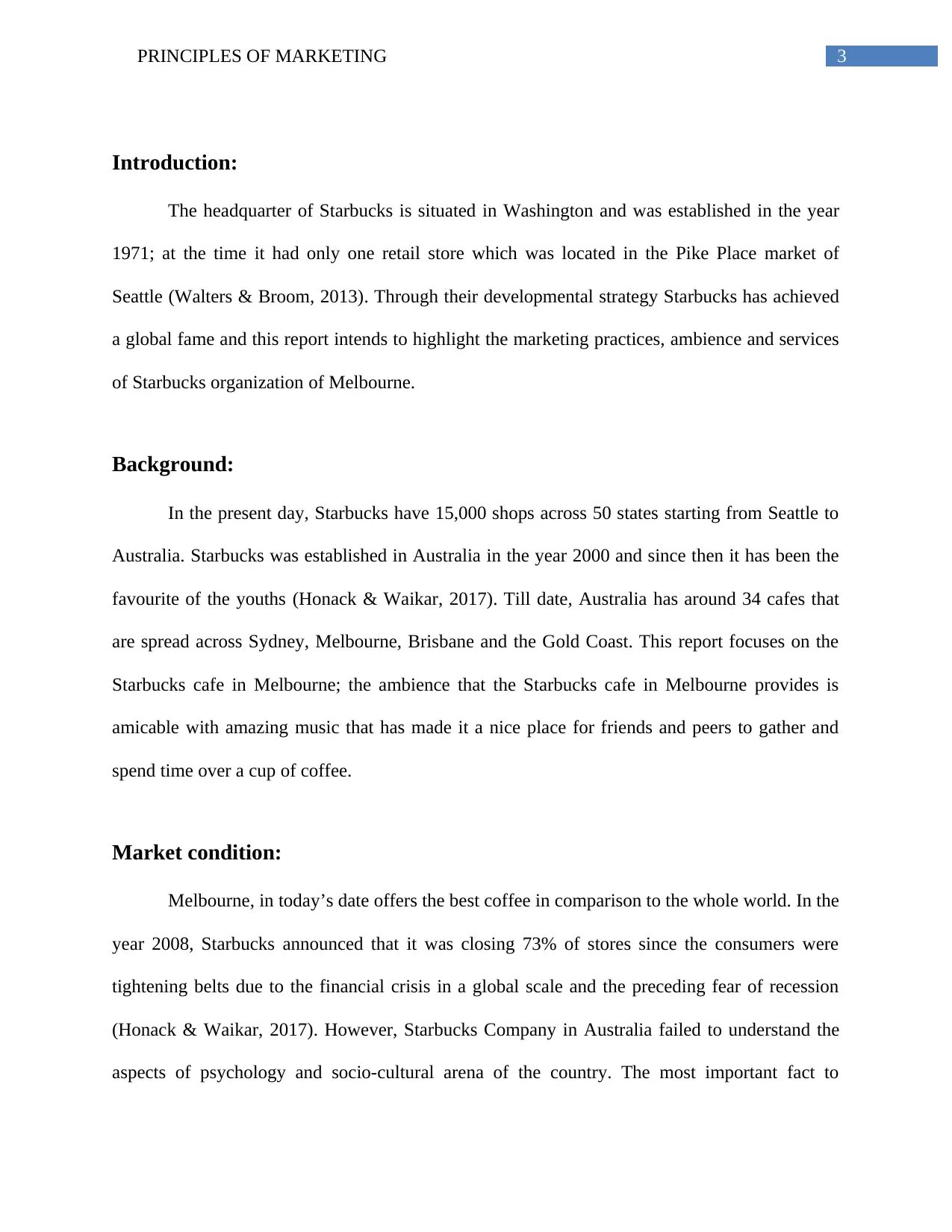
3PRINCIPLES OF MARKETING
Introduction:
The headquarter of Starbucks is situated in Washington and was established in the year
1971; at the time it had only one retail store which was located in the Pike Place market of
Seattle (Walters & Broom, 2013). Through their developmental strategy Starbucks has achieved
a global fame and this report intends to highlight the marketing practices, ambience and services
of Starbucks organization of Melbourne.
Background:
In the present day, Starbucks have 15,000 shops across 50 states starting from Seattle to
Australia. Starbucks was established in Australia in the year 2000 and since then it has been the
favourite of the youths (Honack & Waikar, 2017). Till date, Australia has around 34 cafes that
are spread across Sydney, Melbourne, Brisbane and the Gold Coast. This report focuses on the
Starbucks cafe in Melbourne; the ambience that the Starbucks cafe in Melbourne provides is
amicable with amazing music that has made it a nice place for friends and peers to gather and
spend time over a cup of coffee.
Market condition:
Melbourne, in today’s date offers the best coffee in comparison to the whole world. In the
year 2008, Starbucks announced that it was closing 73% of stores since the consumers were
tightening belts due to the financial crisis in a global scale and the preceding fear of recession
(Honack & Waikar, 2017). However, Starbucks Company in Australia failed to understand the
aspects of psychology and socio-cultural arena of the country. The most important fact to
Introduction:
The headquarter of Starbucks is situated in Washington and was established in the year
1971; at the time it had only one retail store which was located in the Pike Place market of
Seattle (Walters & Broom, 2013). Through their developmental strategy Starbucks has achieved
a global fame and this report intends to highlight the marketing practices, ambience and services
of Starbucks organization of Melbourne.
Background:
In the present day, Starbucks have 15,000 shops across 50 states starting from Seattle to
Australia. Starbucks was established in Australia in the year 2000 and since then it has been the
favourite of the youths (Honack & Waikar, 2017). Till date, Australia has around 34 cafes that
are spread across Sydney, Melbourne, Brisbane and the Gold Coast. This report focuses on the
Starbucks cafe in Melbourne; the ambience that the Starbucks cafe in Melbourne provides is
amicable with amazing music that has made it a nice place for friends and peers to gather and
spend time over a cup of coffee.
Market condition:
Melbourne, in today’s date offers the best coffee in comparison to the whole world. In the
year 2008, Starbucks announced that it was closing 73% of stores since the consumers were
tightening belts due to the financial crisis in a global scale and the preceding fear of recession
(Honack & Waikar, 2017). However, Starbucks Company in Australia failed to understand the
aspects of psychology and socio-cultural arena of the country. The most important fact to
Paraphrase This Document
Need a fresh take? Get an instant paraphrase of this document with our AI Paraphraser

4PRINCIPLES OF MARKETING
understand is that Australia is not a market of homogenous nature; it has over 235 types off
diverse ethnicities and many of them disliked the fact that Australian Starbucks is epitomising
the super-size and high sugar mentality of America (Tisdell, 2017). There are several
competitors of Starbucks in the market like Costa Coffee, McDonalds McCafe, Dunkin Donuts,
Cafe Coffee Day and others in the field of snacks as well which is why Starbucks in Australia
would not have had to face such failure in the market if it had understood the market before
entering.
Target Customers:
The target customers of Starbucks range from diverse characteristics, starting from high
income market to individuals who are aware of their social status and some who are
environmentally conscious. The young female customers of Starbucks have their premium on
their personnel appearance and their health, thus the chain targets these female customers with
beverages of low calories. In the recent times, Starbucks have also started to target wealthy
families by offering products like organic fruit squeezes for the toddlers and more. For targeting
men and women aged from 25 to 44, Starbucks offers certain drinks which are appealing. For the
customers aged from 18 to 24, Starbucks uses the technology and innovation to target them; they
become a place of hang out for the college students, or even a place where they can study or
write papers (Wong, 2014). For children from age 13-17, Starbucks maintains a target by
providing them products like “babyccinos” even though this group forms only about 2% of their
target audience.
understand is that Australia is not a market of homogenous nature; it has over 235 types off
diverse ethnicities and many of them disliked the fact that Australian Starbucks is epitomising
the super-size and high sugar mentality of America (Tisdell, 2017). There are several
competitors of Starbucks in the market like Costa Coffee, McDonalds McCafe, Dunkin Donuts,
Cafe Coffee Day and others in the field of snacks as well which is why Starbucks in Australia
would not have had to face such failure in the market if it had understood the market before
entering.
Target Customers:
The target customers of Starbucks range from diverse characteristics, starting from high
income market to individuals who are aware of their social status and some who are
environmentally conscious. The young female customers of Starbucks have their premium on
their personnel appearance and their health, thus the chain targets these female customers with
beverages of low calories. In the recent times, Starbucks have also started to target wealthy
families by offering products like organic fruit squeezes for the toddlers and more. For targeting
men and women aged from 25 to 44, Starbucks offers certain drinks which are appealing. For the
customers aged from 18 to 24, Starbucks uses the technology and innovation to target them; they
become a place of hang out for the college students, or even a place where they can study or
write papers (Wong, 2014). For children from age 13-17, Starbucks maintains a target by
providing them products like “babyccinos” even though this group forms only about 2% of their
target audience.
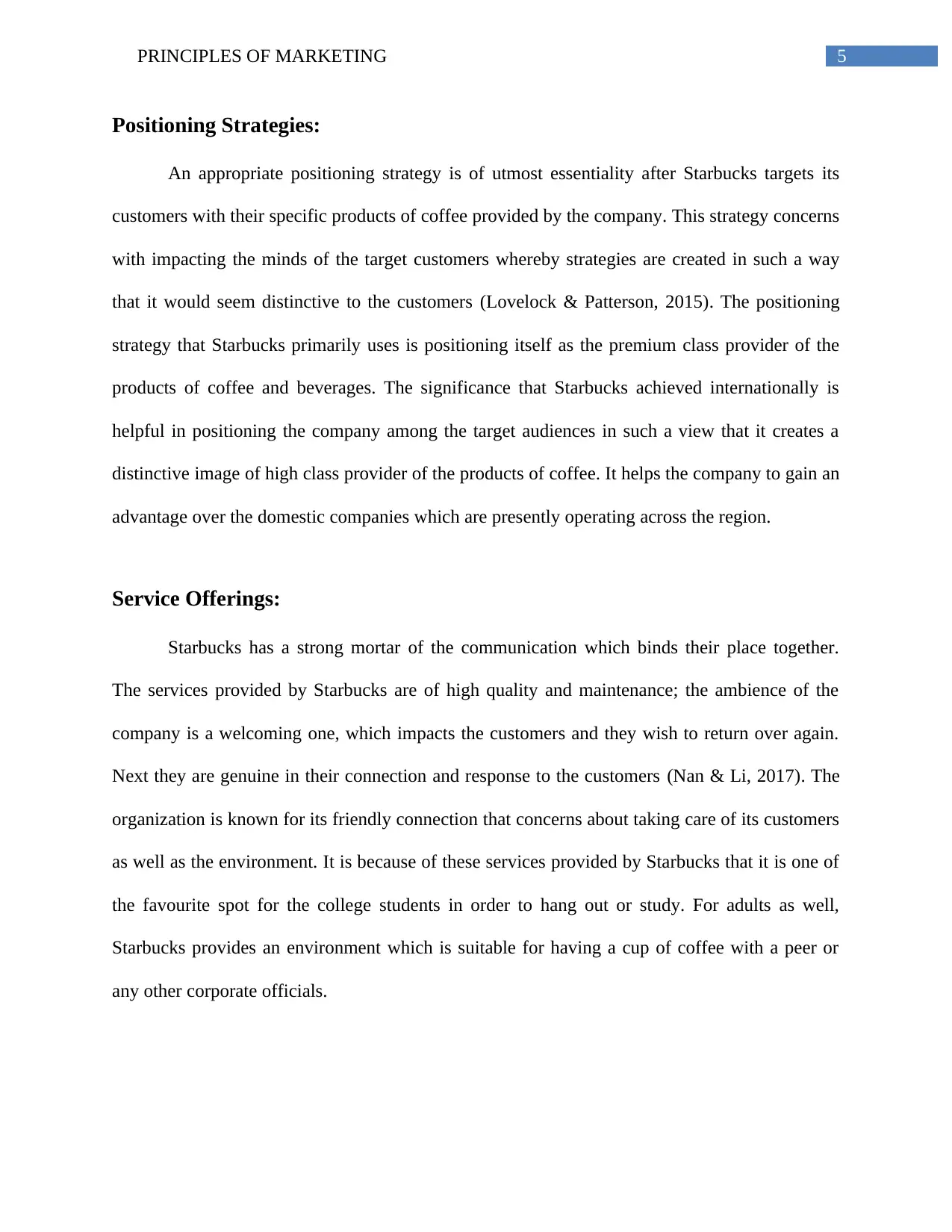
5PRINCIPLES OF MARKETING
Positioning Strategies:
An appropriate positioning strategy is of utmost essentiality after Starbucks targets its
customers with their specific products of coffee provided by the company. This strategy concerns
with impacting the minds of the target customers whereby strategies are created in such a way
that it would seem distinctive to the customers (Lovelock & Patterson, 2015). The positioning
strategy that Starbucks primarily uses is positioning itself as the premium class provider of the
products of coffee and beverages. The significance that Starbucks achieved internationally is
helpful in positioning the company among the target audiences in such a view that it creates a
distinctive image of high class provider of the products of coffee. It helps the company to gain an
advantage over the domestic companies which are presently operating across the region.
Service Offerings:
Starbucks has a strong mortar of the communication which binds their place together.
The services provided by Starbucks are of high quality and maintenance; the ambience of the
company is a welcoming one, which impacts the customers and they wish to return over again.
Next they are genuine in their connection and response to the customers (Nan & Li, 2017). The
organization is known for its friendly connection that concerns about taking care of its customers
as well as the environment. It is because of these services provided by Starbucks that it is one of
the favourite spot for the college students in order to hang out or study. For adults as well,
Starbucks provides an environment which is suitable for having a cup of coffee with a peer or
any other corporate officials.
Positioning Strategies:
An appropriate positioning strategy is of utmost essentiality after Starbucks targets its
customers with their specific products of coffee provided by the company. This strategy concerns
with impacting the minds of the target customers whereby strategies are created in such a way
that it would seem distinctive to the customers (Lovelock & Patterson, 2015). The positioning
strategy that Starbucks primarily uses is positioning itself as the premium class provider of the
products of coffee and beverages. The significance that Starbucks achieved internationally is
helpful in positioning the company among the target audiences in such a view that it creates a
distinctive image of high class provider of the products of coffee. It helps the company to gain an
advantage over the domestic companies which are presently operating across the region.
Service Offerings:
Starbucks has a strong mortar of the communication which binds their place together.
The services provided by Starbucks are of high quality and maintenance; the ambience of the
company is a welcoming one, which impacts the customers and they wish to return over again.
Next they are genuine in their connection and response to the customers (Nan & Li, 2017). The
organization is known for its friendly connection that concerns about taking care of its customers
as well as the environment. It is because of these services provided by Starbucks that it is one of
the favourite spot for the college students in order to hang out or study. For adults as well,
Starbucks provides an environment which is suitable for having a cup of coffee with a peer or
any other corporate officials.
⊘ This is a preview!⊘
Do you want full access?
Subscribe today to unlock all pages.

Trusted by 1+ million students worldwide
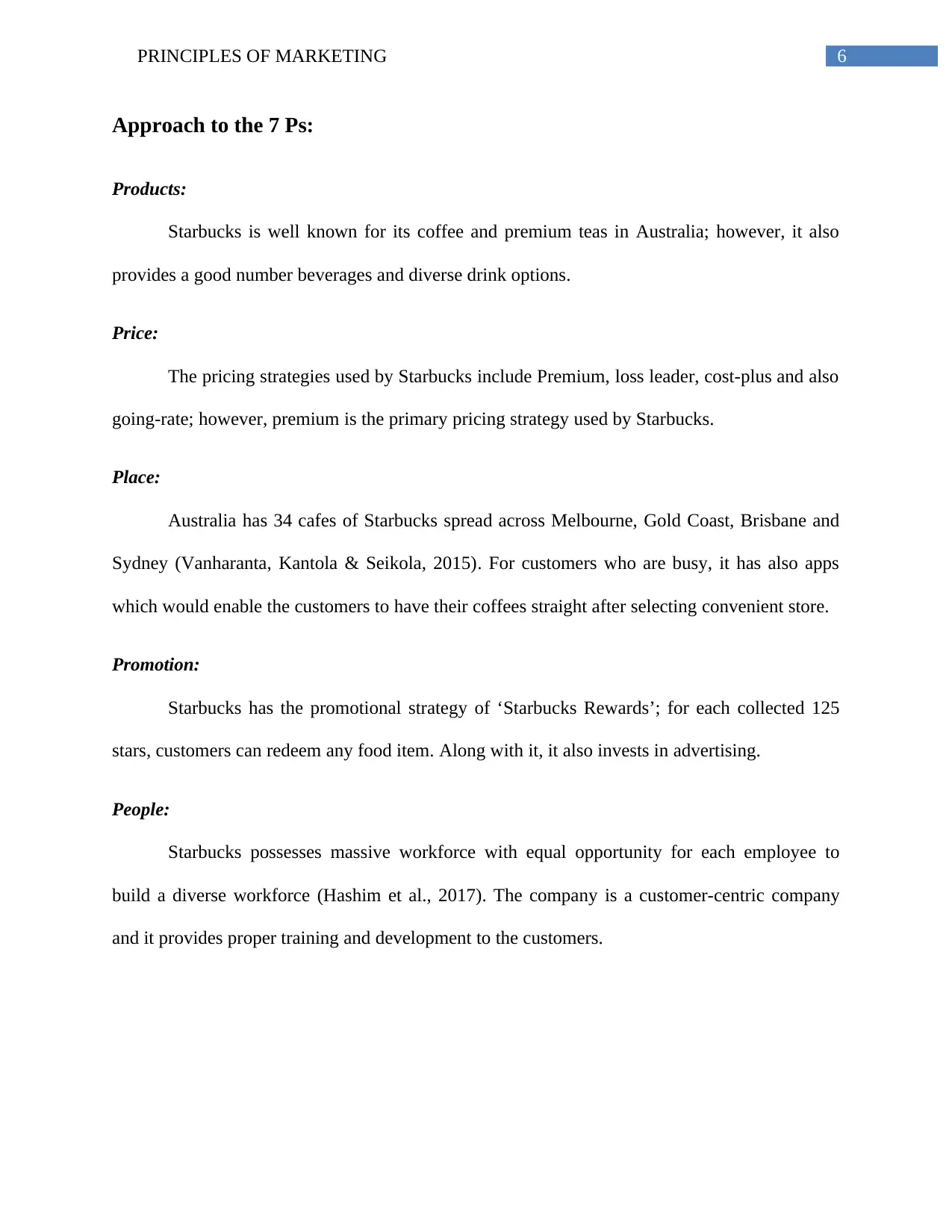
6PRINCIPLES OF MARKETING
Approach to the 7 Ps:
Products:
Starbucks is well known for its coffee and premium teas in Australia; however, it also
provides a good number beverages and diverse drink options.
Price:
The pricing strategies used by Starbucks include Premium, loss leader, cost-plus and also
going-rate; however, premium is the primary pricing strategy used by Starbucks.
Place:
Australia has 34 cafes of Starbucks spread across Melbourne, Gold Coast, Brisbane and
Sydney (Vanharanta, Kantola & Seikola, 2015). For customers who are busy, it has also apps
which would enable the customers to have their coffees straight after selecting convenient store.
Promotion:
Starbucks has the promotional strategy of ‘Starbucks Rewards’; for each collected 125
stars, customers can redeem any food item. Along with it, it also invests in advertising.
People:
Starbucks possesses massive workforce with equal opportunity for each employee to
build a diverse workforce (Hashim et al., 2017). The company is a customer-centric company
and it provides proper training and development to the customers.
Approach to the 7 Ps:
Products:
Starbucks is well known for its coffee and premium teas in Australia; however, it also
provides a good number beverages and diverse drink options.
Price:
The pricing strategies used by Starbucks include Premium, loss leader, cost-plus and also
going-rate; however, premium is the primary pricing strategy used by Starbucks.
Place:
Australia has 34 cafes of Starbucks spread across Melbourne, Gold Coast, Brisbane and
Sydney (Vanharanta, Kantola & Seikola, 2015). For customers who are busy, it has also apps
which would enable the customers to have their coffees straight after selecting convenient store.
Promotion:
Starbucks has the promotional strategy of ‘Starbucks Rewards’; for each collected 125
stars, customers can redeem any food item. Along with it, it also invests in advertising.
People:
Starbucks possesses massive workforce with equal opportunity for each employee to
build a diverse workforce (Hashim et al., 2017). The company is a customer-centric company
and it provides proper training and development to the customers.
Paraphrase This Document
Need a fresh take? Get an instant paraphrase of this document with our AI Paraphraser
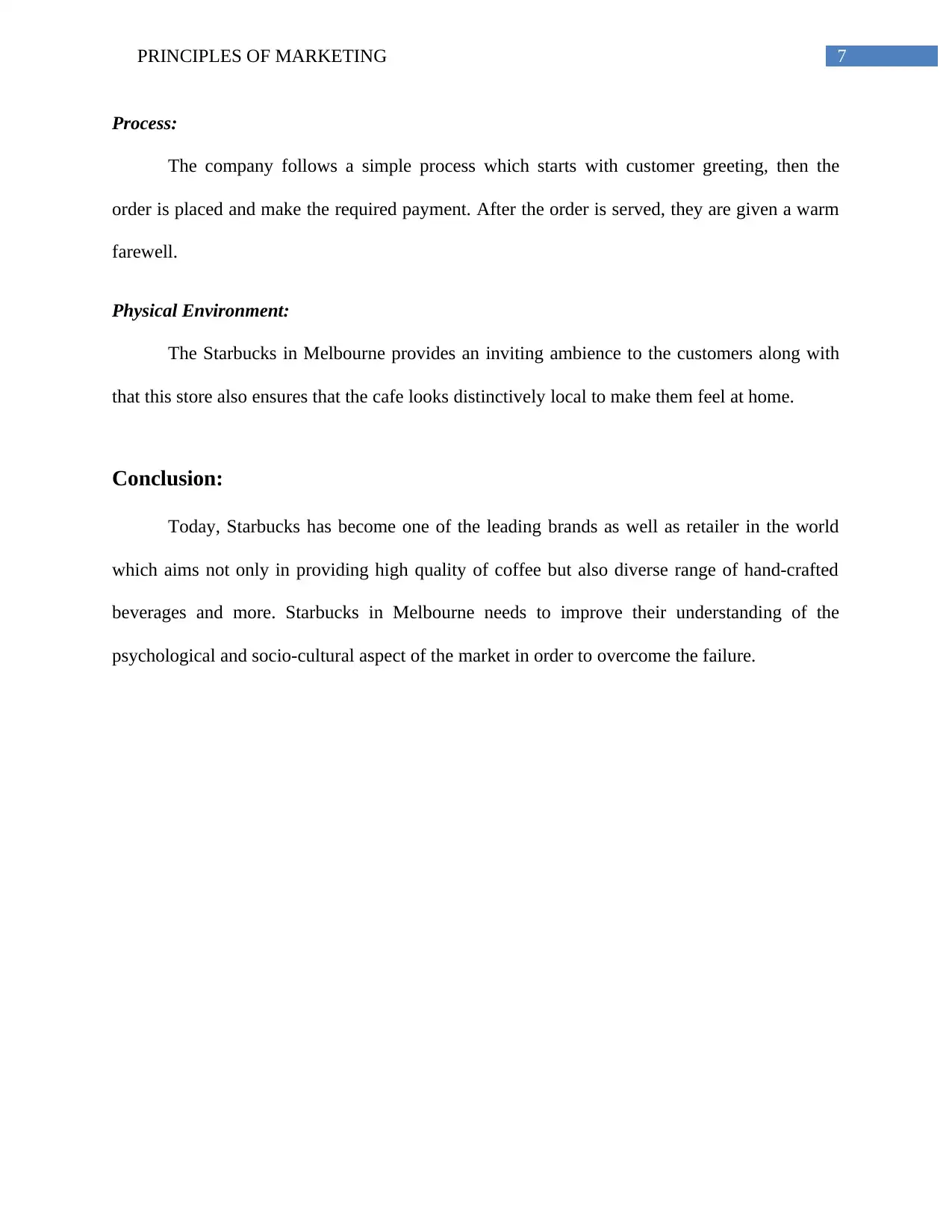
7PRINCIPLES OF MARKETING
Process:
The company follows a simple process which starts with customer greeting, then the
order is placed and make the required payment. After the order is served, they are given a warm
farewell.
Physical Environment:
The Starbucks in Melbourne provides an inviting ambience to the customers along with
that this store also ensures that the cafe looks distinctively local to make them feel at home.
Conclusion:
Today, Starbucks has become one of the leading brands as well as retailer in the world
which aims not only in providing high quality of coffee but also diverse range of hand-crafted
beverages and more. Starbucks in Melbourne needs to improve their understanding of the
psychological and socio-cultural aspect of the market in order to overcome the failure.
Process:
The company follows a simple process which starts with customer greeting, then the
order is placed and make the required payment. After the order is served, they are given a warm
farewell.
Physical Environment:
The Starbucks in Melbourne provides an inviting ambience to the customers along with
that this store also ensures that the cafe looks distinctively local to make them feel at home.
Conclusion:
Today, Starbucks has become one of the leading brands as well as retailer in the world
which aims not only in providing high quality of coffee but also diverse range of hand-crafted
beverages and more. Starbucks in Melbourne needs to improve their understanding of the
psychological and socio-cultural aspect of the market in order to overcome the failure.
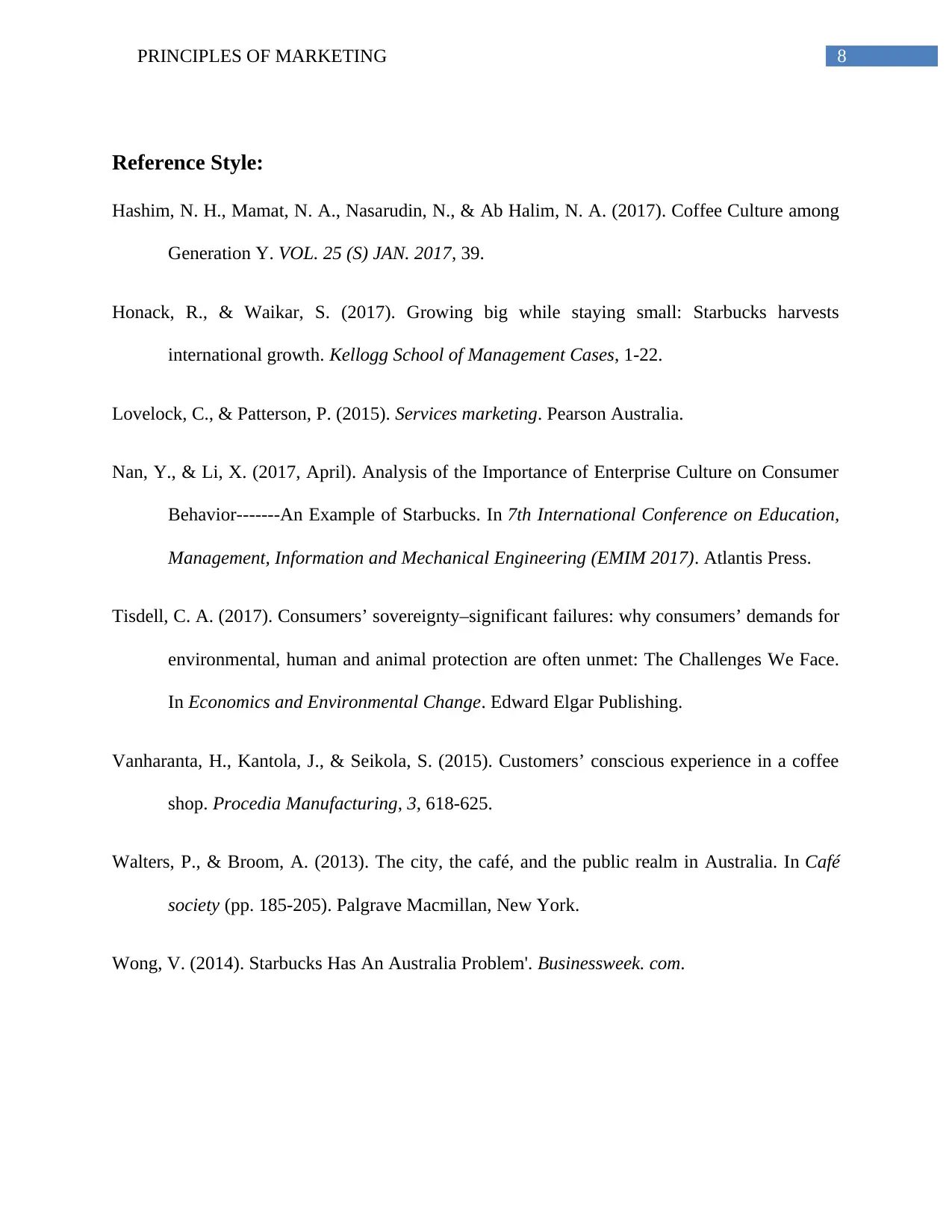
8PRINCIPLES OF MARKETING
Reference Style:
Hashim, N. H., Mamat, N. A., Nasarudin, N., & Ab Halim, N. A. (2017). Coffee Culture among
Generation Y. VOL. 25 (S) JAN. 2017, 39.
Honack, R., & Waikar, S. (2017). Growing big while staying small: Starbucks harvests
international growth. Kellogg School of Management Cases, 1-22.
Lovelock, C., & Patterson, P. (2015). Services marketing. Pearson Australia.
Nan, Y., & Li, X. (2017, April). Analysis of the Importance of Enterprise Culture on Consumer
Behavior-------An Example of Starbucks. In 7th International Conference on Education,
Management, Information and Mechanical Engineering (EMIM 2017). Atlantis Press.
Tisdell, C. A. (2017). Consumers’ sovereignty–significant failures: why consumers’ demands for
environmental, human and animal protection are often unmet: The Challenges We Face.
In Economics and Environmental Change. Edward Elgar Publishing.
Vanharanta, H., Kantola, J., & Seikola, S. (2015). Customers’ conscious experience in a coffee
shop. Procedia Manufacturing, 3, 618-625.
Walters, P., & Broom, A. (2013). The city, the café, and the public realm in Australia. In Café
society (pp. 185-205). Palgrave Macmillan, New York.
Wong, V. (2014). Starbucks Has An Australia Problem'. Businessweek. com.
Reference Style:
Hashim, N. H., Mamat, N. A., Nasarudin, N., & Ab Halim, N. A. (2017). Coffee Culture among
Generation Y. VOL. 25 (S) JAN. 2017, 39.
Honack, R., & Waikar, S. (2017). Growing big while staying small: Starbucks harvests
international growth. Kellogg School of Management Cases, 1-22.
Lovelock, C., & Patterson, P. (2015). Services marketing. Pearson Australia.
Nan, Y., & Li, X. (2017, April). Analysis of the Importance of Enterprise Culture on Consumer
Behavior-------An Example of Starbucks. In 7th International Conference on Education,
Management, Information and Mechanical Engineering (EMIM 2017). Atlantis Press.
Tisdell, C. A. (2017). Consumers’ sovereignty–significant failures: why consumers’ demands for
environmental, human and animal protection are often unmet: The Challenges We Face.
In Economics and Environmental Change. Edward Elgar Publishing.
Vanharanta, H., Kantola, J., & Seikola, S. (2015). Customers’ conscious experience in a coffee
shop. Procedia Manufacturing, 3, 618-625.
Walters, P., & Broom, A. (2013). The city, the café, and the public realm in Australia. In Café
society (pp. 185-205). Palgrave Macmillan, New York.
Wong, V. (2014). Starbucks Has An Australia Problem'. Businessweek. com.
⊘ This is a preview!⊘
Do you want full access?
Subscribe today to unlock all pages.

Trusted by 1+ million students worldwide
1 out of 9
Related Documents
Your All-in-One AI-Powered Toolkit for Academic Success.
+13062052269
info@desklib.com
Available 24*7 on WhatsApp / Email
![[object Object]](/_next/static/media/star-bottom.7253800d.svg)
Unlock your academic potential
Copyright © 2020–2025 A2Z Services. All Rights Reserved. Developed and managed by ZUCOL.





